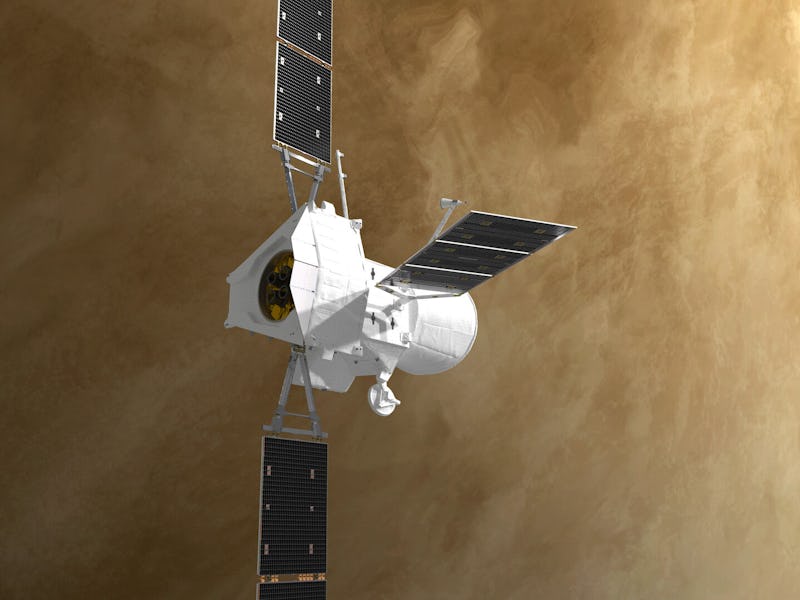Look: New image of Venus released from double spacecraft flyby
It was an unprecedented gravity assist.

It’s been a busy 33 hours for the planet Venus with interplanetary visits from not one, but two, spacecraft.
On August 9 and 10, two European Space Agency spacecraft — Solar Orbiter and BepiColombo — swung by the scorching planet.
BepiColombo is on its way to Mercury but required an extra gravitational push by swinging around Venus.
The Solar Orbiter, as its name might suggest, is on its way to the sun and came within 5,000 miles of Venus on its journey.
The historic double flyby offered scientists an unprecedented opportunity to observe Venus’ atmosphere from different locations at the same time — and snap a few photos.
ESA released an image Wednesday from the BepiColombo flyby, and on Thursday, released a one-minute video compiling other images from the encounter:
This series of images released Thursday show Venus in all its black-and-white glory.
The Solar Orbiter mission is a collaboration between NASA and the European Space Agency aimed at answering some of the unresolved mysteries about our host star:
- What drives solar wind?
- How does the Sun’s magnetic field affect solar activity?
- How does the star influence the Solar System, including our own planet?
On Thursday, NASA released a brief movie of Solar Orbiter’s own encounter with Venus, taken with the Solar Orbiter Heliospheric Imager:
Woooooooooosh.
It will take the Solar Orbiter about two years to reach the Sun, using gravitational boosts from Earth and Venus along the way. The spacecraft made its first flyby of Venus in December 2020.
Meanwhile, BepiColombo, a European-Japanese joint mission, is scheduled to reach Mercury by 2025.
BepiColombo is designed to transform our knowledge of Mercury by studying the planet's surface to identify its composition and geological history, as well as measuring its magnetic conditions.
On Monday and Tuesday, both spacecraft exchanged pleasantries with Venus about 33 hours apart.
First up was Solar Orbiter, which flew by Venus on August 9 with the closest approach of 7,995 km taking place at 04:42 UTC.
A day later, BepiColombo had its closest approach with Venus at 13:48 UTC at an altitude of 550 kilometers.
The maneuver uses the gravitational pull of Venus to adjust the spacecraft's speed slightly and set them on the right trajectory towards their respective destinations.
Shortly after its encounter, an image was released from the BepiColombo flyby:
This image was taken at 13:57 UTC by the Mercury Transfer Module’s Monitoring Camera 3 on BepiColombo, when the spacecraft was 1573 km from Venus.
It’s about more than just a planetary gravitational assist. Both Solar Orbiter and BepiColombo’s also collected data on the magnetic and plasma environment of Venus from different locations.
BepiColombo snapped a total of 89 images of Venus from the Monitoring Cameras aboard the Mercury Transfer Module, coming in at 1024x1024. The color-capable High Resolution Imaging Channel camera was not switched on for the encounter, so all the images came down in black and white.
It still managed to capture a glorious encounter with our sister planet:
These stitched together stills encapsulate the brief but useful flyby of BepiColombo.
The spacecraft waved its first hello to the planet Venus in October 2020, and its latest encounter was the third of nine flybys. Shortly after, ESA released this image:
The first image from the 2020 flyby of Venus by the BepiColombo Mercury mission.
The data taken from the Venus flyby is valuable for upcoming Venus missions such as NASA’s DAVINCI+ and VERITAS, respectively studying the planet’s atmosphere and geological history. ESA’s Venus orbiter EnVision will launch in the 2030s.
NASA last launched a mission to study Venus in 1989 with the Magellan mission.
Although scientists don’t know a lot about Venus, in 2016, NASA computer models of Venus suggested it might have had a habitable surface temperature and shallow water-filled oceans for up to 2 billion years.
In September 2020, scientists found traces of a biosignature gas typically associated with life on Earth. Whether or not it is an indication that there is some form of life on Venus is still unclear, but follow-up observations of the planet are needed.
This is BepiColombo’s last flyby of Venus, according to ESA. After this, it will make six flybys of Mercury, the first on October 1 and 2, 2021, where it will come within 200 km of Mercury. Its second encounter with Mercury will take place on June 23, 2021, and the craft will finally enter orbit on December 5, 2025.